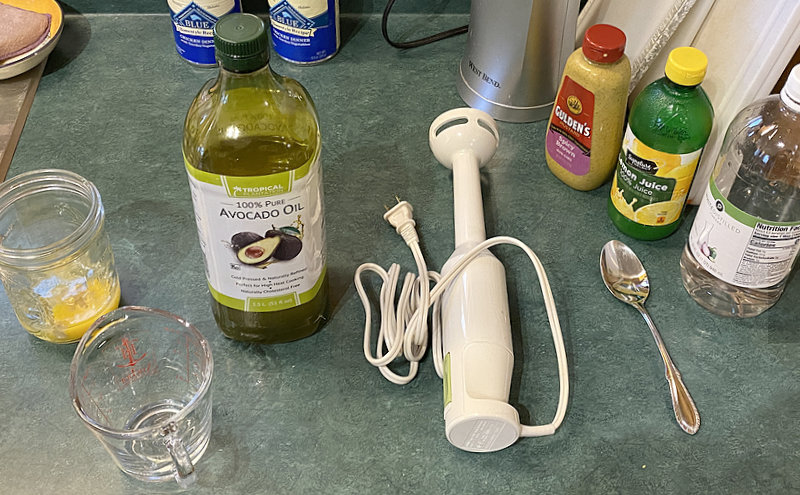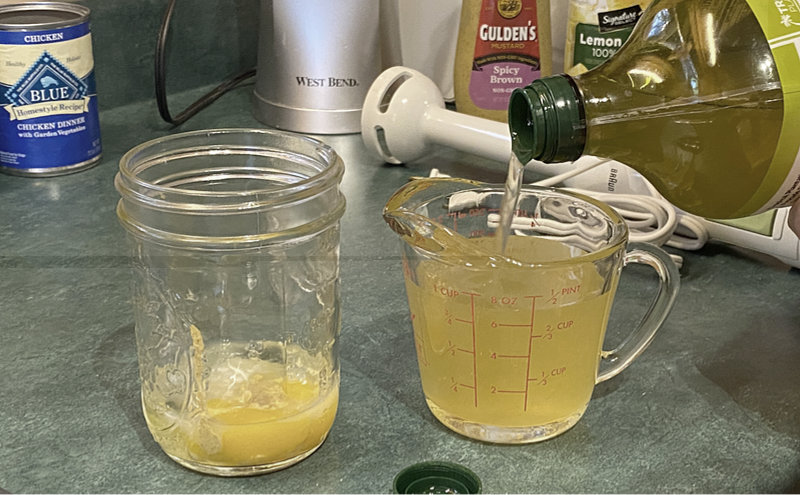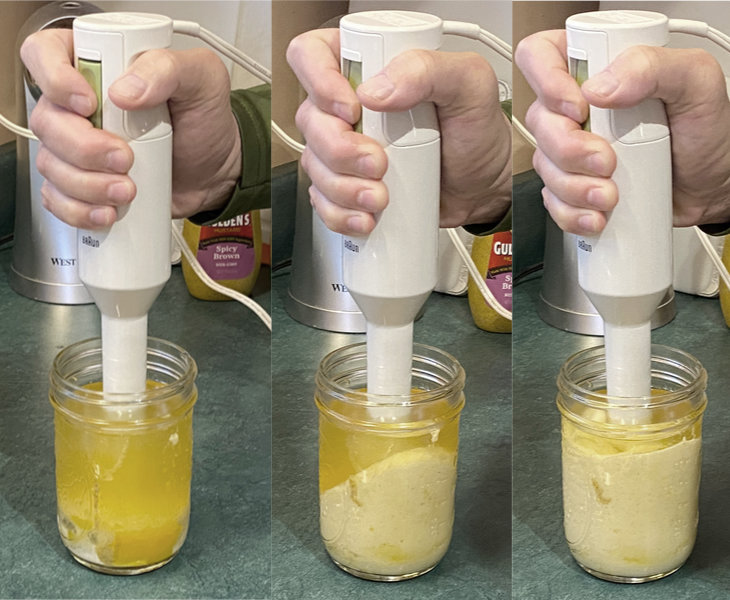How To Make Your Own Mayonnaise With Avocado Oil (or Olive Oil)
Make you own mayonnaise! It’s easier than you might think. Here’s how to do it…
First a quick note. Why do we make our own mayonnaise? Because we control the ingredients. We can choose healthier oils. And as a bonus it costs less than buying it ready-made.
Regular store-bought mayonnaise might contain less-than-healthy ingredients. Especially the oils that are used. Typical Hellmann’s has Soybean oil as the number one ingredient. I’ve even seen Canola oil in some mayo! (not too healthy!)
Well, oil will be the #1 because that’s what’s mostly in there… However I wanted to use Avocado oil or Olive oil instead. Preferably Avocado, which is great for the “Keto” way of eating. Plus believe it or not, lots of these mayonnaise’s have sugar in them too! (There’s seemingly sugar in just about everything these days).
Anyway, instead of paying the big bucks for store-bought Avocado Mayonnaise (which also has other not-so-good ingredients) I decided to make my own.
First, here’s how I’ve made homemade mayonnaise with avocado oil. After that, I’ll show you another recipe (and video) that works with an ordinary blender (found it online).
How To Make Your Own Homemade Mayonnaise With Avocado Oil
Here’s the ingredients you’ll need. I’m making 1 cup of mayo, using Avocado oil.

Ingredients
- Avocado oil
- Vinegar
- Mustard
- Lemon Juice
- An egg (see below for DIY pasteurization)
- Salt
- Wide Mouth canning jar
- Submersible Immersion Blender
Directions to Make Mayonnaise
Let the egg, mustard, and lemon juice get to approximate room temperature. This will probably take about 2 hours. Better mixing that way…
Okay, it’s important to add ingredients in the proper order. More accurately stated, the oil should be last.
- Egg (1)
- Mustard (Tablespoon)
- Lemon Juice (2 teaspoons)
- Vinegar (2 teaspoons)
- Salt (3/4 teaspoon)
- Oil (1 cup)
Note: When I first made this, it was recommended to start with half the quantity of Mustard and Vinegar. This is all obviously subject to your own tastes! So, experiment to your hearts content…

Here you can see I’ve added the egg, mustard, lemon juice and white vinegar. And now I’m filling a measuring cup with 1 cup Avocado oil. Obviously you could be using Extra Virgin Olive oil if you prefer.

Place the Immersion Blender all the way to the bottom. Don’t worry, it’s not going to splash.
Here’s the trick… Start the blender, and then as it magically turns into mayonnaise, slowly LIFT the blender off the bottom and up further towards the top. This will allow the oil that’s sitting on top to mix in more readily.
After you’ve done that, there will still be some oil on top. So just play around with the mixer till it’s blended in. It won’t take very long with this type of high-speed submersible blender.

Homemade Mayonnaise! WhooooWeee! That sure looks good!
Kudos to Mrs.J for taking pictures…
Using A Blender To Make Homemade Mayonnaise With Avocado Oil
I found this from someone named “Dr. Julie”
Ingredients, Recipe, and Video Instructions:
Fast and easy homemade mayonnaise!
1 cup avocado oil
2 egg yolks
1 1/2 tbsp apple cider vinegar
2 tbsp lemon juice
1/2 tsp ground mustard
1/2 tsp salt
How Long Homemade Mayonnaise Will Last In The Refrigerator
The good thing about making your own mayonnaise is there are no chemicals in it. No preservatives.
As a result, it won’t keep as long as store bought mayo.
1 to 2 Weeks.
Tip: Put a piece of white tape on the lid and use a sharpie to mark the production date.
Pasteurize Eggs – How To Do It Yourself
There is a very small chance that raw eggs contain salmonella. Pasteurizing is the process of gentle heating to kill food born illnesses. So it’s generally good practice to pasteurize if using raw egg in a recipe that doesn’t include “cooking” such as homemade mayonnaise for example.
You can do your own online search. But the directions are all pretty much the same…
The pasteurized eggs will still have the consistency of raw eggs and can be stored in the refrigerator after pasteurization.
Start with room temperature eggs.
STEP 1 – Place the eggs you want to pasteurize into a medium-sized saucepan in an even layer. Cover with water so that there is 1″ of water above the eggs. Then remove your eggs. You don’t want them in there until your water is at the right temp.
STEP 2 – Heat the water to 140ºF using a digital thermometer to accurately monitor the temperature. Any warmer than 142ºF and you’re going to cook your eggs.
STEP 3 – Place your (room temperature) eggs in the water. Heat the eggs for 3 1/2 minutes. Make sure the temperature of the water never goes above 142ºF or you will cook your eggs.
STEP 4 – Transfer your pasteurized eggs into a bowl of cold water to stop the heating process. Then store them in the fridge to use later! That’s it!
If you are pasteurizing extra-large eggs from your own chickens then heat them for 5 minutes instead of 3.


My 2 cents worth. My recipe is very similar but with one distinct difference. I pasteurize my raw egg first before mixing everything together. If I feel like getting on the wild side, I add a squirt of plain yellow mustard too.
Thanks for bringing that up. I’ve just added a “how to” for egg pasteurization at the end of the article.
I’ve been told that you have to add the oil while stirring–is that not the case? I like your process better. Using both hands, one or the other is going to start shaking and I’ll end up cleaning home-made mayo off the ceiling…
Yes, if using a regular mixer. However the Immersion blender makes it real easy. Just start at the bottom and slowly pull it up.
Awesome information! Think I might give that a try before we buy more mayo. I’ll bet it tastes better, too.
I love home made mayo. Ken and Mrs J, genius trick with the Mason jar and immersion blender. I always have done it in good processor.
I make my garlic aioli the same way. Gonna use blender instead.
Here is the recipe if anyone is interested.
1 LG egg yolk
4 to 6 med garlic cloves, finely grated
1/2tsp kosher salt
1/2 cup olive oil or avocado oil
1tsp water.
Add all but oil in FP( or now Ken’s Mason jar hack)
Pulse a few times, then add the oil slowly while FP is running.
Tastes great on Calimari.
Thanks again for the new hack, ken.
Peace,
MadFab
sounds delicious
Food processor!
Dang autocorrect, grrrr
MadFab
Super helpful article – with the pasteurization part at the end, I felt like I got an extra article at the end. I make my own ceasar dressing from scratch that’s similar:
Yum….. Grapeseed mayo is good too. I wonder how it would be made without eggs? Going to do a search.
To replace 1 egg, use 1/4 cup bean juice (aka aqua faba) from cooked, unseasoned chickpeas. Or drain the juice from canned chickpeas. All other ingredients the same as the above mayo recipes. Advantage: can be refrigerated for over 2 months and will not separate or spoil. See YT for RoseRed Homestead mayo video.
I made it before from scratch when I ran out and used it with my own flavor–horseradish mustard.
A tip . . . When the mayo is on its last legs, add a teaspoon or so of curry powder, depending on how spicy you like it. The spices help fight the bad germs giving a few more days in the fridge, and give a different flavour. Makes lovely curried egg mayo.
Try it with lime instead of lemon. Slightly different taste, I like it in deviled eggs.
Ignoring my DW’s ‘expert opinion’, I made some of this. As suggested, the mustard and vinegar was halved. The end product was a bit on the ‘yellow/orange’ visual side, but didn’t have an obtrusive taste. The vinegar was right up there as the first detectable ingredient. A note made to ease back on that part. But, I thought it was quite decent. Just to make a point, I made he DW a sandwich with about 80% homemade, 20% store bought mayo…..and she didn’t notice a thing. LOL
My grandma made her own mayo, but it had a bit of sweetness to it as I remember. Not a sugary taste, just sweeter. After mulling it around for a while, I took a little of the ‘homebrew’ mayo and added a teaspoon of the ‘juice’ from Bread and Butter pickles, stirred it up, and hot-damn! That was it. Have to add a little more to the jar I made and re-mix. (Note: B&B pickle juice does have vinegar in it…..so I might just replace the vinegar with B&B juice!) I might just make MY mayo with B&B, and HER mayo with Dill. She likes them ‘movie theater dill pickles’. (I can’t stand them).
Excellent Crow Bait.
I may try that. We make B&B picles also. Home made miracle whip for the bologna Sammy’s on crappy white bread. MMMMM Good!!
Just like when I was a kid. But now we put the bologna in The smoker for about 2 hours. Woo wee is that delish!!
Peace
MadFab
I am surprised there aren’t novelty flavors in the market shelves for Mayo. Your idea sounds great with fridge pickle juice.
These are some flavors I added to mayo
ketchup and mayo for a salad dressing, tastes more like western style.
Jalapeno pepper mayo
Teriyaki-Italian dressing mayo a tangy dip for fries and topping for egg sandwiches too.
What, like their attempt at “Mayo-chup”? Fry sauce, for those who have known it all our lives. I think they keep trying, but their marketing team sucks.